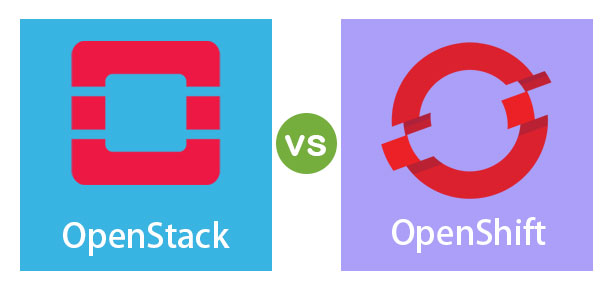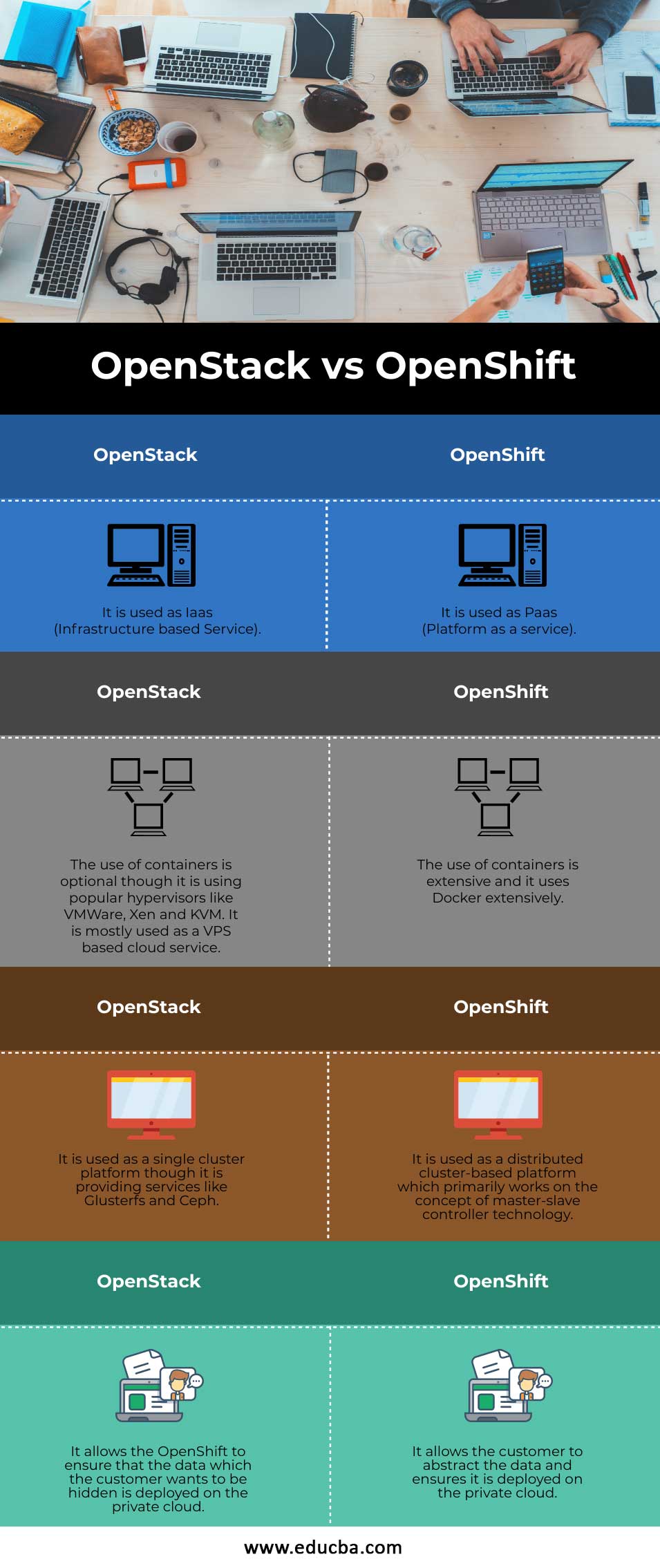Updated March 24, 2023

Difference Between OpenStack and OpenShift
OpenStack vs OpenShift, both being the most popular Linux based Cloud technologies, are Open Source and managed by RedHat corporation. OpenStack is an Iaas (Infrastructure as a service) used to convert the existing servers to the cloud. OpenShift is a Paas (Platform as a service) that runs above the existing cloud services offered by AWS, Google Cloud Platform, etc. Thus, OpenShift can be used as a cloud-based service on OpenStack. This is possible because both technologies are independent of each other. Thus, OpenStack can be used for server infrastructure, while OpenShift can be used as a Third-party API service.
OpenStack
OpenStack, being an Iaas (Infrastructure as a service), can convert the traditional platforms to cloud-based. It allows the customer-based applications to automate their daily workflows like allocation of the resources so that the customer gets an added advantage of using virtual storage services like VPS, block store, object store etc., besides other services. It is primarily being used as a VPS. Generally, hypervisors like VMWare are being used by it to turn on the virtual machines.
OpenShift
OpenShift, being a Paas (Platform as a service), can be used just like it’s counterparts like Google Compute platform, Amazon web services, Microsoft Azure, etc., in terms of its usage. It also supports the developers by making the development and testing workflow of the applications much easier by ensuring that the developers do not have to worry about switching between the physical and the virtual servers whenever required. Thus, it helps to increases the productivity and efficiency of the existing application workflow with reduced maintenance costs.
OpenShift and OpenStack can be used hand in hand in a single customer application workflow. As OpenShift is PaaS (Platform as a service), it can be used over an existing cloud service that is deployed on the OpenStack platform, which is Iaas (Infrastructure as a service). This reduces the setup cost on the part of the customers and increases the existing application workflow’s efficiency and productivity. This also ensures the scalability of the existing application workflow also; as both of the technologies form an integral part of the cloud platform, they can be used independently.
Head to Head Comparison between OpenStack and OpenShift (Infographics)
Below are the top 4 comparisons between OpenStack vs OpenShift:
Key differences between OpenStack and OpenShift
Let us discuss some key differences between OpenStack vs OpenShift in the following points:
1. Containers
OpenStack uses containers in the form of Virtual machines called Hypervisors which can be either VMWare, Xen or KVM. Containers can be used optionally in it as it is used as a VPS by the customers. Hypervisors are the best bet when it comes to their usage along with it. On the other hand, OpenShift is dependent on the containers, and usage is not optional. It uses ideas that define the DevOps platform like Kubernetes, allowing the end customers to develop and test their applications over the cloud platform easily. One of the popular based container-based technology used by it is Docker.
2. Distributed Environment
OpenStack is used as a single point cloud-based platform. It has control over the associated data centers. Still, when compared with popular DevOps based platforms like Kubernetes, it is minimal as Kubernetes can handle the associated data centers in a global cluster. OpenStack also provides Glusterfs and Ceph as storage technologies on a distributed platform. But since they are Third-Party, it does not rely fully on them. On the other hand, OpenShift uses the concept of distributed system extensively as it uses Kubernetes. It works on the master-slave concept that is there is a controller node that is the master node that controls the worker nodes. There is a network layer encapsulated for facilitating ease of communication between the master and the slave nodes.
3. Cloud Platform Service
OpenStack uses Infrastructure as a service that helps in server management attributing similarity with popular cloud-based VPS providers like Google Cloud, Microsoft Azure, Digital Ocean, Amazon Web Services, etc. The end customer can use OpenStack and turn the existing server infrastructure to cloud-based. On the other hand, OpenShift uses Platform as a service that facilitates ease in usage to develop and test end-customer applications. The applications can be run on a container like Docker. Thus, the application can be streamlined into a DevOps based cloud application involving the Continuous Integration/ Continuous Development pipeline.
4. Hybrid Cloud-Based Platforms
The usage of OpenStack and OpenShift can also go hand in hand. If the application has to be abstracted from the other interacting services, OpenShift comes in handy. It ensures that the customer data is kept on the private cloud. This can be done by making the OpenStack run data storage related pods on the private nodal data. It also ensures load balancing as the other data can be handled on a public cloud. Hence, both the above technologies are scalable and easy to use.
Comparison Table of OpenStack vs OpenShift
The table below summarizes the comparisons between OpenStack vs OpenShift:
| OpenStack |
OpenShift |
| It is used as an Iaas (Infrastructure based Service). | It is used as Paas (Platform as a service). |
| The use of containers is optional though it is using popular hypervisors like VMWare, Xen, and KVM. It is mostly used as a VPS based cloud service. | The use of containers is extensive, and it uses Docker extensively. |
| It is used as a single cluster platform though it is providing services like Glusterfs and Ceph. | It is used as a distributed cluster-based platform that primarily works on the concept of master-slave controller technology. |
| It allows OpenShift to ensure that the data which the customer wants to be hidden is deployed on the private cloud. | It allows the customer to abstract the data and ensures it is deployed on the private cloud. |
Conclusion
OpenStack and OpenShift Technologies, based on the Linux platform, are being popularly used by end customers across the globe. They are both great initiatives that are a brainchild of RedHat and are open-source. They are providing stiff competition to the existing cloud-based platforms like Google, Amazon, Microsoft, etc.
Recommended Articles
This is a guide to the top differences between OpenStack vs OpenShift. Here we also discuss the key differences with infographics and comparison table. You may also have a look at the following articles to learn more –

